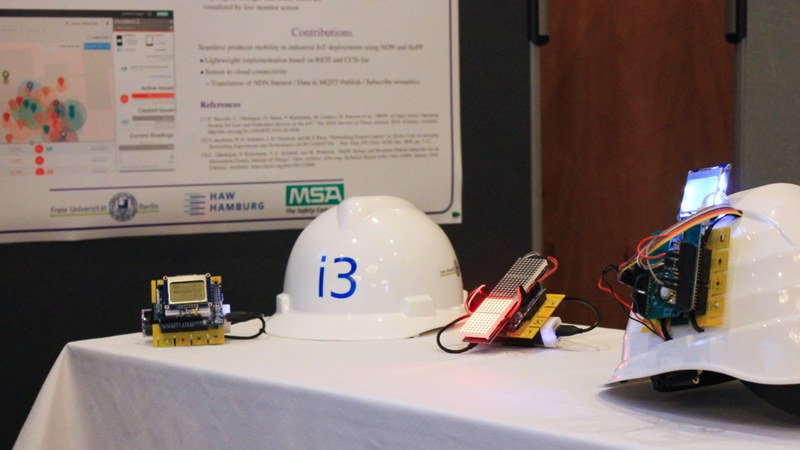I3
Information Centric Networking for the Industrial Internet
Topic and Goals of the Project
Sensors and actors often demand communication requirements in industrial application, both critical for the business and safety. Heterogeneous components – both stationary and mobile – shall be integrated in supra-regional control and monitoring systems and exchange data in a timely and fault tolerant manner. Today’s proprietary and occasionally rudimentary product solutions preclude those requirements. MSA – the leading manufacturer of safety technology and gas detectors worldwide with development site in Berlin, Germany – for example is facing these problems in their product line for sensor controlled fuses and monitoring of industrial systems, oil rigs, fire-brigade operations etc.
The I3 project pursues, motivated by these specific application problems, the goal of the development and testing of mobile local networks critical to safety in industrial applications. The I3 solution will, based on the potentials of content-based routing, modify and extend Content or Information Centric Networking (CCN/ICN) for the needs of the industrial Internet. Especially contributions for security and reliability, for autonomous self-configuration and authentication, for content-base prioritized data differentiation, resource efficiency (e.g. energy, memory) and an abstracted, universal software interface will be adapted. This way I3 wants to increase production efficiency of networking industrial systems as well as simplify the operation of networking components with intelligent solutions on the network layer.
Point of Departure: Innovation Backlog in the Industrial Edge
The vision of a technology standards for an omnipresent industrial Internet enable the smooth integration of machine-to-machine communication in a global information processing system. While the proprietary networking capabilities currently used in industrial systems need to be renewed, presents the Internet Protocol, however, no convincing alternative for two reasons: Firstly is TCP/IP too vulnerable and its security solutions (TLS/IPSec) are too extensive for industrial applications. Secondly requires the “host-to-host” paradigm data transport solutions that are to resource consuming and fragile for the capacity constraints and mobile nodes with lossy connectivity.
Information Centric Networking (ICN) has the potential to solve this problems natively on the network layer. The core idea of this new protocol family is the name-based “hop-by-hop” access on contents (instead of address-based device access) and an ubiquitous caching throughout the network. The use of name-based routing not only decreases the complexity of the network stack but also allows for content-based differentiation and optimization. Caching additionally allows for bypassing of communication failures and for conservation of transmission capacity. This potential nonetheless also brings with it new challenges that I3 needs and wants to find solutions for.
The successful implementation of the industrial Internet will be measured against the following challenges: (a) Fulfillment of differentiated transmission requirements, (b) autonomous, lightweight safety procedures, (c) high reliability, (d) low resource demands, and (e) simple network management. I3 wants to master these challenges with its approach of new network technologies at the “Edge”.
Objective: New Quality by Linking Content Natively to the Network Layer
The I3 project is aiming to develop and test Information Centric Networking as local access technology for the industrial Internet. It pursues the following three core objectives:
- Achievement of a new quality of secure, reliable, and differentiated network services.
- Definition of an integrated architecture of local optimization and wide area network integration.
- Design and standardization of a universal software interface for technology abstraction.
The aspired goals and solutions will be achieved in close cooperation between the partners. The suitability of the developed concepts shall be exemplarily proved and tested in a proof of concept with the gas detection solutions by MSA.

